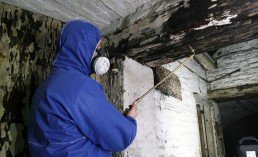Wet rot treatment & why a timber survey is needed
If there’s ever a time to treat damp and wood rot, it’s springtime. But, then, if there’s ever a time for rot to sink its clutches into your property, it’s during winter.
After all, your property has born the brunt of the elements. But at what cost? The snow, wind, and rain might have gone but all can leave behind moisture, which finds its way in through various nooks and crannies.
Timber is where damp takes hold, and if it’s left untreated then rot can develop.
There are two types - dry and wet rot – and it’s the latter we shall focus on here…
…which is good news, in a sense. Why? Because wet rot is not as pervasive as dry rot. It tends not to spread as far, and its consequences tend to be less damaging. The latter can eat its way through a property, affecting wood as well as plaster and brickwork. In terms of structural integrity, it has the potential to be catastrophic.
Wet rot tends only to cause damage in areas that are – and remain – wet.
Poor Ventilation
Poor ventilation below floors may be a cause of wet rot, as might rising or penetrating damp, water leaks and the like.
It’s caused by fungi which multiply in the right conditions and attack wood. Roughly speaking, timber with 20 per cent moisture content or higher is susceptible.
The process starts when the fungi breed by showering millions of microscopic spores into the air.
If they fall on untreated wood they will germinate – via tubes called hypha which spread to form threads called mycelium.
The mycelium eats at the wood and uses the threads (which supply water and nutrients) to propagate.
Again, however, when comparing how dry rot and wet rot can take hold, the latter is not quite so malignant. It will not, for example, spread onto the surface of adjacent stone or brick walls.
That’s because there is fewer mycelium – meaning that wet rot is typically confined to the area of dampness.
Even so, timber exposed to the damp will still lose its structural integrity if left untreated.
Signs of Wet Rot
Tell-tale signs of wet rot might include a whitening, or bleaching, effect - which does not refer to the colour of the mould, but the shade that the timber turns when affected.
By contrast, brown rot will darken the wood, which will disintegrate in small cracks.
While different strains of fungi have different features, broadly speaking they are all similar in appearance and the treatments are also similar.
Regarding identification and treatment, it’s crucial that the type of wood rot – whether it’s dry or wet, in other words - is identified before any course of action is considered. Each requires a different form of treatment.
A detailed inspection should be carried out by a specialist, who will then submit a report detailing both the cause of the decay and the proposed action.
As a rule of thumb, the following (and most likely more besides) will be investigated:
- The Roof. Are the gutters blocked? Perhaps tiles are missing, broken or displaced?
- The Walls. Has the mortar deteriorated? Is the damp-proof course either faulty or missing? Are the air bricks blocked? Maybe pipes are cracked or broken, or a water tank is overflowing?
- Perhaps there is condensation in, say, the bathroom and kitchen? Or maybe there’s moisture close to external gaps or cracks, floors, trapped floodwater, or defective plumbing?
Keeping on top of – or even being aware of – rot can be difficult, but innovations are constantly being made so better help and advice are readily at hand.
If there is doubt, a timber survey is probably your best bet to identify both the cause and remedy, which may include specialist treatment.
Danford Brewer & Ives have a team of expert surveyors who can produce reports and quotations for any necessary specialist works. Moreover, we keep abreast of all the latest innovations, methods and technologies.
If you would like more information on and detail about wet rot - or any of the other building services we offer, such as timber treatment, basement conversions, extensions or building maintenance – then please contact us. As always, we’re more than happy to help.

